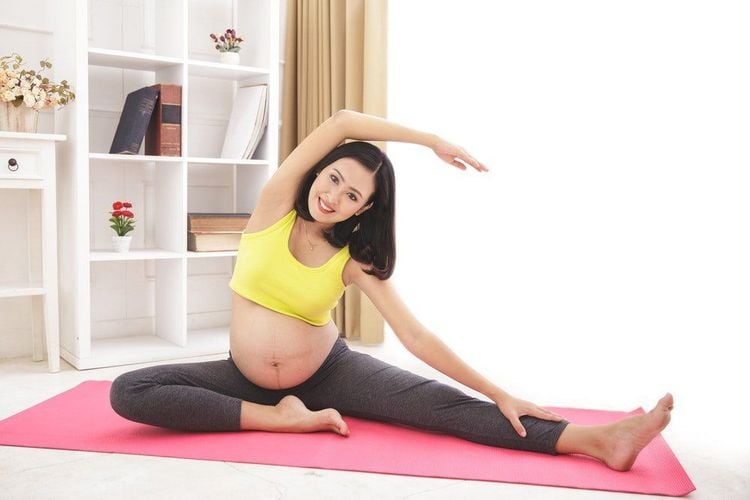This is an automatically translated article.
Exercise may be one of the last things on your mind right now, especially if you're dealing with morning sickness or first-trimester problems. However, staying in shape and active can help you feel comfortable during pregnancy and beyond. Here's more information on how hot yoga differs from other traditional forms, pregnancy safety tips, and questions you should ask your Obstetrician before you practice.1. What is Hot Yoga?
Yoga is well known for the mental and physical benefits they bring to practitioners, especially pregnant women. It's no surprise that there are so many prenatal yoga classes available at gyms and studios around the world - not to mention online courses or videos about prenatal yoga for women. However, although yoga can bring benefits to pregnant women, hot yoga falls into a different category, experts often discourage hot yoga during pregnancy.In its simplest definition, hot yoga is a form of yoga practice performed in a room that is heated to between 32 and 40.5°F. Humidity is also adjusted up which enhances the effect. yoga practice and can help participants perform many difficult poses as well as bring health benefits. However, there are different types of hot yoga classes, so it's important that we know what we need before making a decision whether to practice yoga, especially hot yoga.
For example, Bikram is a particularly powerful form of hot yoga. It is performed in a room set to a hot 40.5°F with a humidity of about 40 percent. Bikram yoga classes typically last for 90 minutes, and students will have to perform a series of specific poses - both standing and stretching - keeping the pressure sustained and the muscle contractions strong. Other forms of hot yoga include performing the usual Hatha or Vinyasa poses in a warmer-than-normal room. Experts at Arizona Pain explain that some instructors in yoga classes may simply raise the temperature to 27 degrees Celsius to add "gentle detoxification and a free-spirited atmosphere" to the classroom in an "infusion" way. their system".

Theo định nghĩa đơn giản nhất, yoga nóng là hình thức tập luyện yoga được thực hiện trong một căn phòng được làm nóng ở nhiệt độ từ 32 đến 40,5 ° F
2. Hot yoga for pregnant women
Once again we want to remind pregnant moms: Experts often discourage them from participating in hot yoga classes during pregnancy. High temperature and pregnancy can be a dangerous combination, especially in the early weeks when your baby is just forming. Also, extra temperature can affect our body in different ways with all the changes you are going through (increased blood flow, hormones, etc.) , there are some exceptions, especially if you are someone who is familiar with this form of exercise and has been practicing it for many years. Even so, we should still consult with an obstetrician-gynecologist to make sure that we are aware of the risk factors of hot yoga as well as any other health concerns that pregnant mothers may have. there may be.What are the risks of hot yoga during pregnancy?
Studies on hot yoga and pregnancy reveal that exercising in a high-temperature environment can cause potential complications for both mother and fetus. These complications include:
Adds stress to the baby. High temperatures tend to make people sweat, and exercising in such conditions increases heat loss in the body. Over time, sweating causes the body to lose fluid – while our heart rate increases and blood volume decreases. Combined, all of these issues can make mothers feel unwell - and their unborn babies become stressed, too. Neural tube defects. Your baby begins to form at conception. The first trimester is a particularly sensitive time for fetal development. Factors such as overheating (hyperthermia) can raise the body's core temperature enough to cause neural tube defects (spondylolisthesis, brain defects, etc.). More specifically, the scientists estimated that increased body temperature could double the risk of neural tube defects. Miscarriage. It has been suggested that hyperthermia may increase the risk of miscarriage, but further research is needed to support this hypothesis.

Có ý kiến cho rằng tăng thân nhiệt có thể làm tăng nguy cơ sảy thai
The American College of Obstetricians and Gynecologists (ACOG) shares that exercising during pregnancy has many benefits. Along with maintaining overall fitness and helping with healthy weight gain during pregnancy, being active can help you lose weight faster after your baby is born. There are also other benefits, including:
Helps relieve aches and pains, such as back pain, hip pain, shoulder pain... Promotes good digestion, relieves constipation. Reduce your risk of potential health problems, including preeclampsia and gestational diabetes This can't be prevented) Keeping mothers' cardiovascular systems (heart and blood vessels) healthy The American College of Obstetricians and Gynecologists also recommend 150 minutes of moderate exercise. every week. This equates to five 30-minute sweat sessions throughout the week. In addition, mothers can also choose more vigorous exercise if they are used to it. Contact a yoga instructor or instructor in your classes for specific instruction based on your background. And if you are new to exercise, start slowly and increase the exercise for best results. Even a 5- to 10-minute workout can benefit you, and you can build on longer sessions as you feel more comfortable.

Các chuyên gia của Trường Cao đẳng Sản phụ khoa Hoa Kỳ cũng khuyên các bà mẹ nên tập thể dục vừa phải 150 phút mỗi tuần
While hot yoga may not be the most ideal exercise during pregnancy, the good news is that room-temperature yoga exercises can be a great part of your routine. familiarity of mothers before giving birth. The benefits of traditional yoga during pregnancy include:
Sleep better Reduce stress and anxiety Increase strength and flexibility Furthermore, regular yoga practice can also help relieve back pain, illness morning sickness, headaches, and even breathing problems as the pregnancy progresses.
Find classes for people who are pregnant, Hatha yoga or restorative yoga. One nice thing about antenatal classes is that you get to meet some like-minded parents to form groups to exchange information and experiences in the future!
If you're still looking for other ways to stay active during pregnancy, try going for a walk around the neighborhood. Experts at the American College of Obstetricians and Gynecologists say that walking "briskly" is a great way to get a full-body workout without over-stressing your muscles and joints. This method is also inexpensive and requires only a good pair of walking shoes and a good source of motivation! In addition, there are many other exercises suitable for pregnant mothers, including:
Swimming or water aerobics. Working out in the pool helps to reduce body weight (literally!), helps the practitioner avoid unnecessary stress and injury. Consider taking a group class. And while moms can feel cool in the pool - don't forget to drink enough water! Indoor cycling. The stationary bicycle is stable and safe from the same hazards as other vehicles on the road. Even better, moms can continue to ride on a stationary bike even if their center of gravity changes in later pregnancy without fear of falling.

Xe đạp cố định ổn định và an toàn trước các mối nguy hiểm như các phương tiện khác lưu thông trên đường
Fitness coaches are an important resource to help us exercise especially during pregnancy. Again, if you've been doing hot yoga for many years, talk to your doctor about whether you can adopt this form of practice during pregnancy. There may be some circumstances in which it may be helpful to continue or change the form of exercise slightly.
In addition, the obstetrician can point to other health aspects of mothers that make hot yoga a form of contraindication for them.
Some other questions mothers can ask include:
Are there any activity-related restrictions that I should be aware of during my pregnancy? What room temperature is considered too hot? (Remember, the range for “hot” yoga can be anywhere between 27°C and 41°C.) Is hot yoga okay after the first trimester? Is doing yoga in a room temperature a good choice for me? What other types of exercises should I try? How much activity should I aim for each week? How much water should I drink when exercising? How soon after pregnancy can I start doing hot yoga again?

Yoga nóng không được khuyến khích dành cho các bà mẹ mang thai
Please dial HOTLINE for more information or register for an appointment HERE. Download MyVinmec app to make appointments faster and to manage your bookings easily.
Reference sources: healthline.com, aaptiv.com












